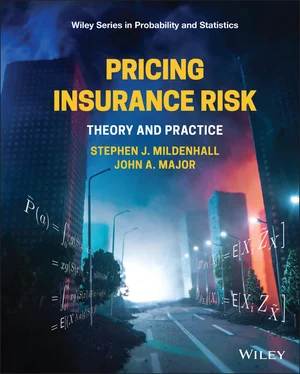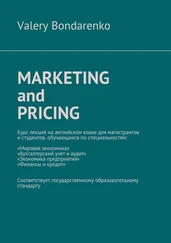Stephen J. Mildenhall - Pricing Insurance Risk
Здесь есть возможность читать онлайн «Stephen J. Mildenhall - Pricing Insurance Risk» — ознакомительный отрывок электронной книги совершенно бесплатно, а после прочтения отрывка купить полную версию. В некоторых случаях можно слушать аудио, скачать через торрент в формате fb2 и присутствует краткое содержание. Жанр: unrecognised, на английском языке. Описание произведения, (предисловие) а так же отзывы посетителей доступны на портале библиотеки ЛибКат.
- Название:Pricing Insurance Risk
- Автор:
- Жанр:
- Год:неизвестен
- ISBN:нет данных
- Рейтинг книги:4 / 5. Голосов: 1
-
Избранное:Добавить в избранное
- Отзывы:
-
Ваша оценка:
- 80
- 1
- 2
- 3
- 4
- 5
Pricing Insurance Risk: краткое содержание, описание и аннотация
Предлагаем к чтению аннотацию, описание, краткое содержание или предисловие (зависит от того, что написал сам автор книги «Pricing Insurance Risk»). Если вы не нашли необходимую информацию о книге — напишите в комментариях, мы постараемся отыскать её.
A comprehensive framework for measuring, valuing, and managing risk Pricing Insurance Risk: Theory and Practice
Pricing Insurance Risk: Theory and Practice
Pricing Insurance Risk — читать онлайн ознакомительный отрывок
Ниже представлен текст книги, разбитый по страницам. Система сохранения места последней прочитанной страницы, позволяет с удобством читать онлайн бесплатно книгу «Pricing Insurance Risk», без необходимости каждый раз заново искать на чём Вы остановились. Поставьте закладку, и сможете в любой момент перейти на страницу, на которой закончили чтение.
Интервал:
Закладка:
Loss statistics based on a Fast Fourier Transform (FFT) approximation (see Section 2.4.5) are shown in Table 2.5. The FFT approximation is essentially exact and it is used for all graphics and illustrations. Simulation can also be used. Table 4.6 shows various VaR, TVaR, and EPD levels. See the important comment in Section 2.4.5 regarding computational methods.
Table 2.5 Tame Case Study estimated mean, CV, skewness and kurtosis by line and in total, gross and net. Aggregate reinsurance applied to B with an attachment probability 0.2 (¤ 56) and detachment probability 0.01 (¤ 69)
| Gross | Net | |||||
|---|---|---|---|---|---|---|
| Statistic | A | B | Total | A | B | Total |
| Mean | 50.000 | 50.000 | 100.000 | 50.000 | 49.084 | 99.084 |
| CV | 0.100 | 0.150 | 0.090 | 0.100 | 0.123 | 0.079 |
| Skewness | 0.200 | 0.300 | 0.207 | 0.200 | −0.484 | −0.169 |
| Kurtosis | 0.060 | 0.135 | 0.070 | 0.060 | −0.474 | −0.157 |
Figure 2.2 shows the loss densities. The spike in the lower left plot is caused by the reinsured unit B hitting its limit, which produces a probability mass. Its magnitude is clear on the lower right, log scale, plot. The tail behavior of the two units is similar. Both have log concave gross densities. Figure 2.3 shows the bivariate plots. The outcomes are tightly clustered about their expected values.
2.4.3 Catastrophe and Non-Catastrophe Case Study
In the Cat/Non-Cat Case Study, Ins Co. has catastrophe and noncatastrophe exposures. The noncatastrophe unit proxies a small commercial lines portfolio. Balancing the relative benefits of units considered to be more stable against more volatile ones is a very common strategic problem for insurers and reinsurers. It arises in many different guises:
Should a US Midwestern company expand to the East coast (and pick up hurricane exposure)?
Should an auto insurer start writing homeowners?
What is the appropriate mix between property catastrophe and noncatastrophe exposed business for a reinsurer?
This Case uses a stochastic model similar to the Tame Case. The two units are independent and have gamma and lognormal distributions with parameters shown in Table 2.4.
The Case includes a gross and net view. Net applies aggregate reinsurance to the Cat unit with an attachment probability 0.1 (¤ 41) and detachment probability 0.005 (¤ 121).
Loss statistics based on an FFT approximation are shown in Table 2.6. The FFT approximation is good, though not as exact as the first case, and it is used for all graphics and illustrations. Simulation can also be used. Table 4.7 shows various VaR, TVaR, and EPD levels.
Table 2.6 Cat/Non-Cat Case Study estimated mean, CV, skewness, and kurtosis by line and in total, gross, and net. Aggregate reinsurance applied to Cat with an attachment probability 0.1 (¤ 41) and detachment probability 0.005 (¤ 121)
| Gross | Net | |||||
|---|---|---|---|---|---|---|
| Statistic | Cat | Non-Cat | Total | Cat | Non-Cat | Total |
| Mean | 20.000 | 80.000 | 100.000 | 17.786 | 80.000 | 97.786 |
| CV | 1.000 | 0.150 | 0.233 | 0.737 | 0.150 | 0.182 |
| Skewness | 3.972 | 0.300 | 2.539 | 3.139 | 0.300 | 1.351 |
| Kurtosis | 35.933 | 0.135 | 19.173 | 55.220 | 0.135 | 16.336 |
Figure 2.4 shows the loss densities. The top left plot shows the different body behavior. Non-Cat is close to symmetric. Cat has a peaked distribution, with mode much lower than mean. The spike in the net plots is caused by claims generating a limit loss to the reinsurance on Cat. The different tail behavior of the two units is evident, especially on a log scale. noncat has a log concave density whereas Cat is eventually log convex. The impact of reinsurance is clear. It introduces a point mass at the aggregate attachment for Cat. The total distribution is still continuous. Figure 2.5 shows the bivariate plots. The left plot emphasizes the different tail behavior; Non-Cat remains localized close to its mean while Cat decays very slowly (vertically).
2.4.4 Hurricane and Severe Storm Case Study
In the Hu/SCS Case Study, Ins Co. has catastrophe exposures from severe convective storms (SCS) and, independently, hurricanes (Hu). In practice, hurricane exposure is modeled using a catastrophe model. We proxy that using a very severe lognormal distribution in place of the gross catastrophe model event-level output. Both units are modeled by an aggregate distribution with a Poisson frequency and lognormal severity. The key stochastic parameters are shown in Table 2.4.
The Case includes a gross and net view. Net applies per occurrence reinsurance to the Hu unit with an attachment probability 0.05 (¤ 40) and detachment probability 0.005 (¤ 413). The reinsurance assumes an unlimited number of free reinstatements, to simplify computations. In practice, the net distribution would include inuring property per risk and quota share programs. It would be taken from the net catastrophe model event-level output.
Other attritional (i.e., noncatastrophe) losses are approximately constant in comparison, therefore we can exclude them from our calculations since reasonable risk measures are translation-invariant,. Loss statistics based on an FFT approximation are shown in Table 2.7. To improve convergence the FFT approximation limits all occurrence losses to 1.2×109, which accounts for the difference in means compared to the expected 100. All graphics are based on the FFT computation, but computations are shown based on FFT and simulation approaches. Table 4.8 shows various VaR, TVaR, and EPD levels.
Table 2.7 Hu/SCS Case Study estimated mean, CV, skewness, and kurtosis by line and in total, gross, and net. Per occurrence reinsurance applied to Hu with an attachment probability 0.05 (¤ 40) and detachment probability 0.005 (¤ 413)
| Gross | Net | |||||
|---|---|---|---|---|---|---|
| Statistic | Hu | SCS | Total | Hu | SCS | Total |
| Mean | 29.727 | 69.133 | 98.860 | 18.987 | 69.133 | 88.121 |
| CV | 10.923 | 0.736 | 3.324 | 16.246 | 0.736 | 3.548 |
| Skewness | 121 | 24.900 | 116 | 137 | 24.900 | 132 |
| Kurtosis | 27 | 9 | 26 | 32 | 9 | 31 |
Figure 2.6 shows the loss densities. These are more extreme versions of the Cat/Non-Cat Case. Cat is extremely skewed. The lognormal severity is thick-tailed for both units, though Cat is thicker. Figure 2.7 shows the bivariate plots. The right-hand plot shows the pinched behavior typical of thick-tailed distributions. A large loss combined with a small loss is the most likely nontrivial outcome. The distribution is clustered around the axes.
2.4.5 Computational Methods
All of the computations we show were completed in Python, R, or a spreadsheet—and sometimes all three. All of the simple discrete examples are easy to replicate in a spreadsheet. There is no conceptual jump from the spreadsheet examples to the R and Python Case Studies, just an increase in the numerical complexity. Once you can implement in a spreadsheet, you understand well enough to program, or instruct a programmer to create, a production implementation.
Читать дальшеИнтервал:
Закладка:
Похожие книги на «Pricing Insurance Risk»
Представляем Вашему вниманию похожие книги на «Pricing Insurance Risk» списком для выбора. Мы отобрали схожую по названию и смыслу литературу в надежде предоставить читателям больше вариантов отыскать новые, интересные, ещё непрочитанные произведения.
Обсуждение, отзывы о книге «Pricing Insurance Risk» и просто собственные мнения читателей. Оставьте ваши комментарии, напишите, что Вы думаете о произведении, его смысле или главных героях. Укажите что конкретно понравилось, а что нет, и почему Вы так считаете.












